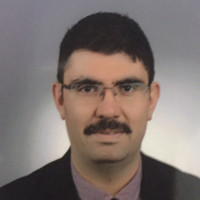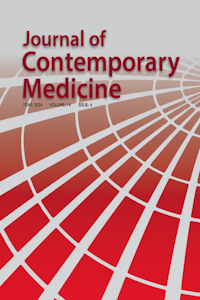Research Article
Clinical Research
Case Report
Letter to Editor
Systematic Reviews and Meta Analysis
Systematic Reviews and Meta Analysis
1. Reverse Shoulder Arthroplasty in the Treatment of Cuff Tear Arthropathy: Systematic ReviewIssue Reviewers












 Web
Web



İlk orta ve lise tahsilimi İstanbul’da tamamladı. 1998 yılında Selçuk Üniversitesi Tıp Fakültesinden mezun oldu. 1998-2000 yılları arasında Bayburt Merkez 1 No’lu Sağlık Ocağı'nda pratisyen hekim olarak görev yaptı. 2000-2006 yılları arasında Atatürk Üniversitesi Tıp Fakültesi Çocuk Cerrahisi Ana Bilimdalı'nda ihtisas eğitimimi tamamladı. İhtisas eğitimi sırasında 2004 yılında Amerika Birleşik Devletleri Michigan C.S. Mott Childrens’ Hospital’da 3 ay süreyle gözlemci asistan olarak çalıştı. 2006 tarihinde uzman oldu. 2006-2011 yılları arasında Diyarbakır Çocuk Hastalıkları Hastanesi'nde uzman olarak çalıştı. Bu süre içinde 2006-2007 tarihleri arasında GATA Çocuk Cerrahisi Kliniği'nde Uzman Tabip Asteğmen olarak askerlik görevini yaptı. 2011-2013 tarihlerinde Konya Eğitim ve Araştırma Hastanesi Çocuk Cerrahisi Kliniği'ne çalıştı. 2013 mart ayından itibaren Selçuk Üniversitesi tıp fakültesi Çocuk Cerrahisi Anabilim Dalında Öğretim üyesi olarak çalışmaya başladı.2018'de Doçent Doktor ünvanını aldı,28 aralık 2023'de profesörlük ünvanını aldı. Evli ve 3 çocuk babasıdır.

Aim & Scope
Journal of Contemporary Medicine is published bimonthly for six issues.
Its purpose is to publish high-quality original clinical and experimental studies, case reports and letters to the editor.
It will be published on January 1, 2021 in English only.
Our journal is under evaluation in TR Index.
Again, starting from January 2021, a publication will be made to complete a volume with 6 issues per year. (bimonthly)
The aim of the journal is to present high quality original research articles in the field of medicine.
Additionally manuscripts in the format of review, case report, articles about clinical and practical applications and editorials, short report, book reviews, biographies, and letters to the editor are also published in the journal.
Besides if related with medicine, articles on aspects of dentistry, social sciences, public health, genetics, psychology, pshyciatrics, educational sciences, sociology and nursery could be published.
Journal of Contemporary Medicine is an open-access journal that publishes articles in accordance with the open-access model based on the Budapest Open Access Initiative (BOAI) Declaration. The journal's archive is available at www.jcontempmed.com free of charge.
The definition of OA introduced in the original BOAI:
"By “open access” to [peer-reviewed research literature], we mean its free availability on the public internet, permitting any users to read, download, copy, distribute, print, search, or link to the full texts of these articles, crawl them for indexing, pass them as data to software, or use them for any other lawful purpose, without financial, legal, or technical barriers other than those inseparable from gaining access to the internet itself. The only constraint on reproduction and distribution, and the only role for copyright in this domain, should be to give authors control over the integrity of their work and the right to be properly acknowledged and cited."
You can reach the BOAI at the below:
https://www.budapestopenaccessinitiative.org/boai-10-recommendations
The content published in the Journal of Contemporary Medicine is licenced under the terms of the Creative Commons 4.0 International Citation Licence.
[you] hereby transfer your copyright to us (Journal of Contemporary Medicine).
In particular, this means that you grant us the non-exclusive right, for the full term of copyright and any renewals/extensions thereof,
both to reproduce and distribute your article (including the abstract) ourselves throughout the world in printed, electronic or any other medium”
You are free to:
Share — copy and redistribute the material in any medium or format
NonCommercial — You may not use the material for commercial purposes
NoDerivatives — If you remix, transform, or build upon the material, you may not distribute the modified material



Author Guidelines
The Journal will not consider manuscripts any that have been published elsewhere, or manuscripts that are being considered for another publication, or are in press. Studies previously announced in the congresses are accepted if this condition is stated. If any part of a manuscript by the same author(s) contains any information that was previously published, a reprint or a copy of the previous article should be submitted to the Editorial Office with an explanation by the authors
A technical review is performed to confirm that all of the required documentation has been submitted and to conduct a preliminary evaluation of the manuscript and supplementary files to assess suitability for the Journal. The manuscript will be returned to the Author in the event of any deficiency. Journal of Contemporary Medicine operates a blind review process. Contributions deemed suitable are then typically sent to a minimum of two independent expert reviewers in the field of study to assess the scientific quality of the paper. (You can see at the picture below)
The Editor/Editors are responsible for the final decision regarding acceptance or rejection of articles. The Editor's decision is final. If necessary, author(s) may be invited to submit a revised version of the manuscript. This invitation does not imply that the manuscript will be accepted for publication. Revised manuscripts must be sent to the Editorial Office within 4 (four) weeks, otherwise they will be considered as a new application. The corresponding author will be notified of the decision to accept or reject the manuscript for publication.
Statements and suggestions published in manuscripts are the authors’ responsibility and do not reflect the opinions of the Editor, Associate Editors and the Editorial Board members.
The manuscript will not be returned to the authors whether the article is accepted or not. Copyright fee is not paid for the articles published in the journal. A copy of the journal will be sent to the corresponding author.
Language of the Journal
The official languages of the Journal are English. ( Before 2021 both Turkish and English) The manuscripts that are written in English have abstracts in Turkish, which makes the abstracts available to Turkish audience.
Authorship Criteria
After accepted for publication, all the authors will be asked to sign “CoyrightTransfer Form” which states the following: “ This work is not under active consideration for publication, has not been accepted for publication, nor has it been published, in full or in part (except in abstract form). I confirm that the study has been approved by the ethics committee. ” All authors should agree to the conditions outlined in the form.
Journal of Contemporary Medicine has agreed to use the standards of the International Committee of Medical Journal Editors. The author(s) should meet the criteria for authorship according to the "Uniform Requirements for Manuscripts Submitted to Biomedical Journals: Writing and Editing for Biomedical Publication. It is available at www.icmje.org.
Ethical Responsibility
Ethical Responsibility / Rules:The protocol of clinical research articles must be approved by the Ethics Committee.
In all studies conducted on humans, the “Material and Method” section was approved by the relevant committee or the Helsinki Declaration of Principles (https://www.wma.net/what-we-do/medical-ethics/declaration-of-helsinki/).
It should be stated in the text that all persons included in the study signed the am Informed Consent Form ”.
The articles submitted to the Journal of Contemporary Medicine will be deemed to have been conducted in accordance with the Helsinki Declaration of Principles, and have received ethical and legal permissions and will not be held responsible.
If the “Animal” item was used in the study, the authors stated that in the Material and Method section of the article, they protect the animal rights in their studies in accordance with the principles of Guide for the Care and Use of Laboratory Animals (www.nap.edu/catalog/5140.html) and that they have received approval from the ethics committees of their institutions. must specify.
In case reports, Informed Consent a should be obtained from patients regardless of the identity of the patient.
If the article includes the institution (directly or indirectly) providing financial support for the commercial connection or work, the authors; the commercial product used, the drug, the company has no commercial relationship with, or if there is any relationship (consultant, other agreements, etc.), the editor must inform the presentation page.
If Ethics Committee Approval is required in the article; the received document should be sent with the article.
The manuscript should be submitted to the Academic Plagiarism Prevention Program by the authors.
It is the authors' responsibility to ensure that the article complies with the ethical rules
Policy of Screening for Plagiarism
The manuscripts are scanned by the Journal using the iThenticate program for determination of plagiarism and non-ethical situations. Journal of Contemporary Medicine will immediately reject manuscripts leading to plagiarismTYPES OF MANUSCRIPT
Manuscripts should be submitted online via
https://dergipark.org.tr/journal/2980/submission/start
Original Articles should not exceed 3000 words and should be arranged
under the headings of Abstract (not more than 250 words), Introduction,
Materials and Methods, Results, Discussion, Conclusion and References.
Case Reports should not exceed 1000 words and 10 references, and should be arranged as follows: Abstract, Introduction, Case Report, Discussion and References. It may be accompanied by only one figure or table.
Letter to the Editor should not exceed 500 words. Short relevant comments on medical and scientific issues, particularly controversies, having no more than five references and one table or figure are encouraged. Where letters refer to an earlier published paper, authors will be offered right of reply.
Reviews are not accepted unless written on the invitation of the Editorial Board.
PREPARATION OF MANUSCRIPTS
All articles submitted to the Journal must comply with the following instructions:
a) Submissions should be doubled-spaced and typed in Arial 10 points.
b) All pages should be numbered consecutively in the top right-hand corner, beginning with the title page.
c) The title page should not include the names and institutions of the authors.
d) The manuscript should be presented in the following order: Title page, Abstract (English, Turkish), Keywords (English, Turkish), Introduction, Materials and Methods, Results, Discussion, Conclusion, Acknowledgements (if present), References, Figure Legends, Tables (each table, complete with title and foot-notes, on a separate page) and Appendices (if present) presented each on a separate page.
Title
The title should be short, easy to understand and must define the contents of the article.
Abstract
Abstract should be in both English and Turkish and should consist “Aim, Materials and Methods, Results and Conclusion”. The purpose of the study, the setting for the study, the subjects, the treatment or intervention, principal outcomes measured, the type of statistical analysis and the outcome of the study should be stated in this section (up to 250 words). Abstract should not include reference. No abstract is required for the letters to the Editor.
Keywords
Not more than five keywords in order of importance for indexing purposes should be supplied below the abstract and should be selected from Index Medicus Medical Subject Headings (MeSH), available at www.nlm.nih.gov/meshhome.html.
Text
Authors should use subheadings to divide sections regarding the type of the manuscript as described above. Statistical methods used should be specified in the Materials and Methods section.
References
In the text, references should be cited using Arabic numerals in parenthesis in the order in which they appear. If cited only in tables or figure legends, they should be numbered according to the first identification of the table or figure in the text. Names of the journals should be abbreviated in the style used in Index Medicus. The names of all authors should be cited when there are six or fewer; when seven or more, the first three should be followed by et al. The issue and volume numbers of the referenced journal should be added.
References should be listed in the following form:
Journal article
Teke Z, Kabay B, Aytekin FO et al. Pyrrolidine dithiocarbamate prevents 60 minutes of warm mesenteric ischemia/reperfusion injury in rats. Am J Surg 2007;194(6):255-62.
Supplement
Solca M. Acute pain management: Unmet needs and new advances in pain management.
Eur J Anaesthesiol 2002; 19(Suppl 25): 3-10.
Online article not yet published in an issue
Butterly SJ, Pillans P, Horn B, Miles R, Sturtevant J. Off-label use of rituximab in a tertiary Queensland hospital. Intern Med J doi: 10.1111/j.1445-5994.2009.01988.x
Book
Sample1: Murray PR, Rosenthal KS, Kobayashi GS, Pfaller MA. Medical
microbiology. 4th ed. St. Louis: Mosby; 2002.
Sample 2: Sümbüloğlu K, Akdağ B. Regresyon Yöntemleri ve Korelasyon Analizi. Hatiboğlu Yayınevi: Ankara; 2007.
Chapter in a book
Meltzer PS, Kallioniemi A, Trent JM. Chromosome alterations in human solid tumors. I n: Vogelstein B, Kinzler KW, editors. The genetic basis of human cancer. New York: McGraw-Hill; 2002. p. 93113.
Journal article on the Internet
Abood S. Quality improvement initiative in nursing homes: The ANA acts in an advisory role. Am J Nurs [serial on the Internet] 2002 [cited 12 Aug 2002]; 102. Available from:
www.nursingworld.org/AJN/2002/june/wawatch.htm
Website
Cancer-pain.org [homepage on the Internet]. New York: Association of Cancer
Online Resources [updated 16 May 2002; cited 9 Jul 2002]. Available from:
www.cancer-pain.org
An organization as an author
The Intensive Care Society of Australia and New Zealand. Mechanical ventilation strategy in ARDS: Guidelines. Int Care J Aust 1996;164:282-4.
Acknowledgements
The source of financial grants and the contribution of colleagues or
institutions should be acknowledged.
Tables
Tables should be complementary, but not duplicate information contained in the
text. Tables should be numbered consecutively in Arabic numbers, with a
descriptive, self-explanatory title above the table. All abbreviations should
be explained in a footnote. Footnotes should be designated by symbols in the
following order: *,†, ‡, §, ¶.
Figures
All illustrations (including line drawings and photographs) are classified as
figures. Figures must be added to the system as separate .jpg or .gif
files (approximately 500x400 pixels, 8 cm in width and at least 300 dpi
resolution). Figures should be numbered consecutively in Arabic numbers and
should be cited in parenthesis in consecutive order in the text.
Figure Legends
Legends should be self-explanatory and positioned on a separate page. The legend should incorporate definitions of any symbols used and all abbreviations and units of measurements should be explained. A letter should be provided stating copyright authorization if figures have been reproduced from another source.
Measurements and Abbreviations
All measurements must be given in metric system (Système International d'Unités, SI). Example: mg/kg, µg/kg, mL, mL/kg, mL/kg/h, mL/kg/min, L/min, mmHg, etc. Statistics and measurements should always be given in numerals, except where the number begins a sentence. When a number does not refer to a unit of measurement, it is spelt out, except where the number is greater than nine.
Abbreviations that are used should be defined in parenthesis where the full word is first mentioned. Some common abbreviations can be used, such as iv, im, po, and sc.
Drugs should be referred to by their generic names, rather than brand names.
Editorial Correspondence
Prof. Dr. Resul YILMAZ
Selçuk Üniversitesi, Tıp Fakültesi
Çocuk Yoğun Bakım Bilim Dalı
Alaeddin Keykubat Yerleşkesi Selçuklu/Konya 42075 Türkiye
Phone: +90 (332) 241 50 00-44513
Faks: +90 (332) 241 21 84
Journal of Contemporary Medicine
(Çağdaş Tıp Dergisi)
e-posta: cagdastipdergisi @gmail.com
Ethical Principles and Publication Policy
Ethics Policy
Publication Ethics
The publication process at Journal of Contemporary Medicine is the basis of the improvement and dissemination of information objectively and respectfully. Therefore, the procedures in this process improves the quality of the studies. Peer-reviewed studies are the ones that support and materialize the scientific method. At this point, it is of utmost importance that all parties included in the publication process (authors, readers and researchers, publisher, reviewers and editors) comply with the standards of ethical considerations. Journal of Contemporary Medicine expects all parties to hold the following ethical responsibilities.
The journal's publication processes are executed in accordance with the guides, International Medical Journals Editors Board (ICMJE), World Association of Medical Editors (WAME), Council of Science Editors (CSE), Committee on Publication Ethics (COPE), European Association of Science Editors (EASE) ,National Information Standards Organization (NISO) and DOAJ-Principles of Transparency and Best Practice in Scholarly Publishing
International Medical Journals Editors Board (ICMJE),
World Association of Medical Editors (WAME),
Council of Science Editors (CSE),
Committee on Publication Ethics (COPE),
European Association of Science Editors (EASE),
National Information Standards Organization (NISO)
DOAJ-Principles of Transparency and Best Practice in Scholarly Publishing
Ethical Responsibilities of Authors
• The authors who submit their manuscripts to Journal of Contemporary Medicine are expected to comply with the following ethical responsibilities:
• Author(s) must submit original studies to the journal. If they utilize or use other studies, they must make the in-text and end-text references accurately and completely.
• People who have not contributed to the study at the intellectual level should not be indicated as author.
• If the manuscripts submitted to be published are subject of conflicting interests or relations, these must be explained.
• During the review process of their manuscripts, author(s) may be asked to supply raw data. In such a case, author(s) should be ready to submit such data and information to the editorial and scientific boards.
• Author(s) should document that they have the participants' consent and the necessary permissions related with the sharing and research/analysis of the data that are used.
• Author(s) bears the responsibility to inform the editor of the journal or publisher if they happen to notice a mistake in their study which is in early release or publication process and to cooperate with the editors during the correction or withdrawal process.
• Authors cannot submit their studies to multiple journals simultaneously. Each submission can be made only after the previous one is completed. A study published in another journal cannot be submitted to Journal of Contemporary Medicine.Author responsibilities given in a study (e.g.: adding an author, reordering of author names) whose review process has begun cannot be changed.
Ethical Responsibilities of Editors
The editor and field editors of Journal of Contemporary Medicine should hold the following ethical responsibilities that are based on the guides "COPE Code of Conduct and Best Practice Guidelines for Journal Editors" and "COPE Best Practice Guidelines for Journal Editors" published as open Access by Committee on Publication Ethics (COPE).
General duties and responsibilities
Editors are responsible for each study published in J Contemp Med. In this respect, the editors have the following roles and responsibilities:
• Making efforts to meet the demand for knowledge from readers and authors,
• Ensuring the continuous development of the journal,
• Managing the procedures aimed to improve the quality of the studies published in the journal,
• Supporting freedom of expression,
• Ensuring academic integrity,
• Following the procedures without making concessions on intellectual property rights and ethical standards,
• Being transparent and clear in issues that require correction or explanation.
Relationships with Readers
Editors must make decisions taking into consideration the knowledge, skills and expectations of all readers, researchers and practitioners need. They must also ensure that the published studies contribute to literature and be original. Moreover, they must take notice of the feedback received from researchers and practitioners and provide explanatory and informative feedback.
Relationships with Authors
Editors have the following duties and responsibilities in their relations with authors:
• Editors must make positive or negative decisions about the studies' importance, originality, validity, clarity in wording and suitability with the journal's aims and objectives.
• Editors must accept the studies that are within the scope of publication into pre review process unless there are serious problems with the study.
• Editors must not ignore positive suggestions made by reviewers unless there are serious problems with the study.
• New editors, unless there are serious issues, must not change the previous editor's decisions about the studies.
• "Blind Review and Review Process" must be published and editors must prevent possible diversions in the defined processes.
• Authors should be provided with explanatory and informative feedback.
Relationships with Reviewers
Editors have the following duties and responsibilities in their relations with reviewers:
Editors must
• Choose reviewers according to the subject of the study.
• Provide the information and guidance reviewers may need during the review process.
• Observe whether there are conflicting interests between reviewers and authors.
• Keep the identities of reviewers confidential in blind review.
• Encourage the reviewers to review the manuscript in an unbiased, scientific and objective tone.
• Develop practices and policies that increase the performance of reviewers.
• Take necessary steps to update the reviewer pool dynamically.
• Prevent unkind and unscientific reviews.
• Make effort to ensure the reviewer pool has a wide range.
Relationships with the Editorial Board
Editors must make sure that the members of the editorial board follow the procedures in accordance with the publication policies and guidelines, and must inform the members about the publication policies and developments.
Moreover, editors must
• Ensure that the members of the editorial board review the manuscripts in an unbiased and independent manner.
• Select the new members of the editorial board from those who can contribute to the journal and are qualified enough.
• Send manuscripts for review based on the subject of expertise of the editorial board members.
• Regularly communicate with the editorial board.Arrange regular meetings with the editorial board for the development of publication policies and the journal.
Relationships with the Journal's Owner and Publisher
The relationship between the editors and publisher is based on the principle of the independency of editors. All the decisions made by the editors are independent of the publisher and the owner of the journal as required by the agreement made between editors and publisher.
Editorial and Blind Review Processes
Editors are obliged to comply with the policies of "Blind Review and Review Process" stated in the journal's publication policies. Therefore, the editors ensure that each manuscript is reviewed in an unbiased, fair and timely manner.
Quality Assurance
Editors must make sure that articles in the journal are published in accordance with the publication policies of the journal and international standards.
Protection of Personal Information
Editors are supposed to protect the personal information related with the subjects or visuals in the studies being reviewed, and to reject the study if there is no documentation of the subjects' consent. Furthermore, editors are supposed to protect the personal information of the authors, reviewers and readers.
Encouraging Ethical Rules and Protection of Human and Animal Rights
Editors are supposed to protect human and animal rights in the studies being reviewed and must reject the experimental studies which do not have ethical and related committee’s approval about the population given in such studies.
Precautions against possible Abuse and Malpractice
Editors are supposed to take precautions against possible abuse and malpractice. They must conduct investigations meticulously and objectively in determining and evaluating complaints about such situations. They must also share the results of the investigation.
Ensuring Academic Integrity
Editors must make sure that the mistakes, inconsistencies or misdirections in studies are corrected quickly.
Protection of Intellectual Property Rights
Editors are responsible for protecting the intellectual property rights of all the articles published in the journal and the rights of the journal and author(s) in cases where these rights are violated. Also, editors must take the necessary precautions in order to prevent the content of all published articles from violating the intellectual property rights of other publications.
Constructiveness and Openness to Discussion
Editors must
• Pay attention to the convincing criticism about studies published in the journal and must have a constructive attitude towards such criticism.
• Grant the right of reply to the author(s) of the criticized study.
• Not ignore or exclude the study that include negative results.
Complaints
Editors must examine the complaints from authors, reviewers or readers and respond to them in an explanatory and enlightening manner.
Political and Economic Apprehensions
Neither the owner of the journal, publisher or any other political or economical factor can influence the independent decision taking of the editors.
Conflicting Interests
Editors, acknowledging that there may be conflicting interests between reviewers and other editors, guarantee that the publication process of the manuscripts will be completed in an independent and unbiased manner
Ethical Responsibilities of Reviewers
The fact that all manuscripts are reviewed through "Blind Review" has a direct influence on the publication quality. This process ensures confidentiality by objective and independent review. The review process at J Contemp Med is carried out on the principle of double blind review. Reviewers do not contact the authors directly, and the reviews and comments are conveyed through the journal management system. In this process, the reviewer views on the evaluation forms and full texts are assigned to the author(s) by the editor. Therefore, the reviewers doing review work for J Contemp Med are supposed to bear the following ethical responsibilities:
Reviewers must
• Agree to review only in their subject of expertise.
• Review in an unbiased and confidential manner.
• Inform the editor of the journal if they think that they encounter conflict of interests and decline to review the manuscript during the review process.
• Dispose the manuscripts they have reviewed in accordance with the principle of confidentiality after the review process. Reviewers can use the final versions of the manuscripts they have reviewed only after publication.
• Review the manuscript objectively and only in terms of its content and ensure that nationality, gender, religious and political beliefs, and economic apprehension do not influence the review.
• Review the manuscript in a constructive and kind tone, avoid making personal comments including hostility, slander and insult.
• Review the manuscript they have agreed to review on time and in accordance with the ethical rules stated above.
Ethical Responsibilities of Publisher
Publisher of Journal of Contemporary Medicine
• The Editors and the Editorial Board of J Contemp Med are conscious of the fact that they must observe the ethical responsibilities below and act accordingly:
• Editors are responsible for all the processes that the manuscripts submitted to Journal of Contemporary Medicine will go through. Within this framework, ignoring the economic or political interests, the decision-makers are the editors.
• The publisher undertakes to have an independent editorial decision made.
• The publisher protects the intellectual property rights of all the articles published in J Contemp Med and holds the responsibility to keep a record of each unpublished article.
• The publisher bears all the responsibility to take the precautions against scientific abuse, fraud and plagiarism.
Unethical Behaviour
Should you encounter any unethical act or content in J Contemp Med apart from the ethical responsibilities listed above, please notify the journal by e-mail at cagdastipdergisi@gmail.com.
Briefly:
Authorship Criteria
After accepted for publication, all the authors will be asked to sign “Coyright Transfer Form” which states the following: “ This work is not under active consideration for publication, has not been accepted for publication, nor has it been published, in full or in part (except in abstract form). I confirm that the study has been approved by the ethics committee. ” All authors should agree to the conditions outlined in the form.
Journal of Contemporary Medicine has agreed to use the standards of the International Committee of Medical Journal Editors. The author(s) should meet the criteria for authorship according to the "Uniform Requirements for Manuscripts Submitted to Biomedical Journals: Writing and Editing for Biomedical Publication. It is available at www.icmje.org.
Ethical Responsibility Ethical Responsibility / Rules:
The protocol of clinical research articles must be approved by the Ethics Committee.
In all studies conducted on humans, the “Material and Method” section was approved by the relevant committee or the Helsinki Declaration of Principles (https://www.wma.net/what-we-do/medical-ethics/declaration-of-helsinki/).
It should be stated in the text that all persons included in the study signed the am Informed Consent Form ”.
The articles submitted to the Journal of Contemporary Medicine will be deemed to have been conducted in accordance with the Helsinki Declaration of Principles, and have received ethical and legal permissions and will not be held responsible.
If the “Animal” item was used in the study, the authors stated that in the Material and Method section of the article, they protect the animal rights in their studies in accordance with the principles of Guide for the Care and Use of Laboratory Animals (https://grants.nih.gov/grants/olaw/guide-for-the-care-and-use-of-laboratory-animals.pdf) and that they have received approval from the ethics committees of their institutions. must specify.
In case reports, Informed Consent a should be obtained from patients regardless of the identity of the patient.
If the article includes the institution (directly or indirectly) providing financial support for the commercial connection or work, the authors; the commercial product used, the drug, the company has no commercial relationship with, or if there is any relationship (consultant, other agreements, etc.), the editor must inform the presentation page.
If Ethics Committee Approval is required in the article; the received document should be sent with the article.
The manuscript should be submitted to the Academic Plagiarism Prevention Program by the authors.
It is the authors' responsibility to ensure that the article complies with the ethical rules
Policy of Screening for Plagiarism
The manuscripts are scanned by the Journal using the iThenticate program for determination of plagiarism and non-ethical situations. Journal of Contemporary Medicine will immediately reject manuscripts leading to plagiarism
Price Policy
Journal Charge Policy
Journal of Contemporary Medicine is a peer-reviewed, open-access journal, which is published 6 issues per year periodically and is indexed in international indexes (ÜAK 1b). The journal's expenses have been covered by its own resources and donations so far. Due to the increasing publication costs with the increase in the number of articles, the article processing fee will be requested from the authors who submit articles as of January 01, 2023, in order to evaluate the articles as soon as possible and to provide better consultancy and editing services, regardless of rejection or acceptance. This application fee, which is not subject to the condition of acceptance or rejection, is requested after the compliance of the article to the journal scope is checked. Click here to see the author's clarification text about the Paradtory/questionable journals (Council OF Higher Education=CoHE (YÖK) Criteria Questions and answers question 44).
https://www.uak.gov.tr/Documents/docentlik/2021-ocak-donemi/2021O_SikcaSorulanSorularveCevaplari_10022021.pdf
This publication fee is paid in advance at the beginning of the submission process, after the compliance of the article with the scope of the journal is checked, and will not be refunded in case of withdrawal or rejection. The person submitting the article is responsible for making and arranging the payment. The corresponding author must confirm at the time of submission that he will organize the payment. Payment of the fee does not mean that the article will be accepted. Articles with positive referee evaluation results will be accepted in accordance with ethical rules. In other words, the acceptance decision is based on the decision of the referees evaluating the article. In order to increase the publication possibility of the articles, the article should be prepared according to the relevant guidelines (STROBE, CONSORT, CARE). Your article will not be published without English editing. If academic English editing is required, you can use MediHealth Academy, Protranslate, Enago editing/proofreading services for the revised/final version of your article.
Article submission payment: Original articles of the authors are 3000 TL (Turkish Liras) or 100 USD (US Dollars); for review and case report articles, 1500 TL (Turkish Liras) or 50 USD (US Dollars) are required. No fee will be required for 'invited reviews', and 'letter to the editor' articles), which is not subject to acceptance/rejection conditions, will be made at cagdastipdergisi@gmail.com
Fast-track process: All following processes; evaluation for editorial pre-review, prerequisites check, blind review at least by two reviewers, editorial decision; will be concluded within 21 working days (Fast-track process fee = 2 x processing charge). Being a fast-track does not increase the chance of article acceptance. If the article is rejected as a result of the referee evaluation, the fee is not refunded.

